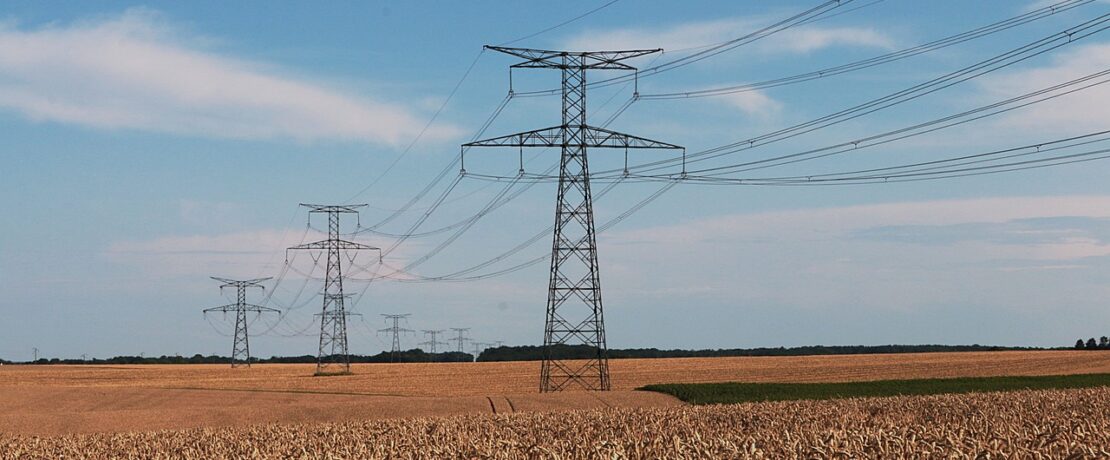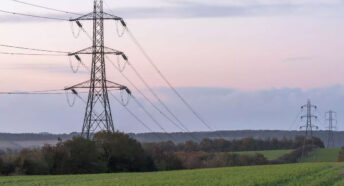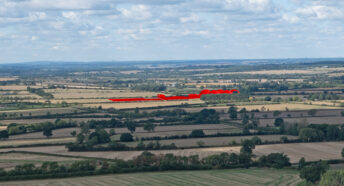Pylon invasion
By Dr. Phil Bratby, a Devon CPRE Trustee
In 1938 the Council for the Preservation of Rural England, as CPRE was then known, made a short promotional film which was shown in cinemas throughout the UK. Not only was it advertising the charity, but the film was highlighting the need for this country to designate national parks and urging public support. One of the key aims was to protect the unspoilt countryside from pylons. To quote from the film:
“Let us have the great open country. For country like this the CPRE has been fighting a battle for many years, fighting to preserve such unspoilt beauty as this, from unsightly pylons.”
CPRE had indeed been battling to protect the countryside from unsightly pylons since its inception in 1926, with many eminent people joining the cause. The Times letters page from the 1920s and 30s would regularly feature the issue. The matter was of great importance to CPRE.
But now, nearly 100 years later, and as we approach the centenary of CPRE itself, it appears that the countryside will be faced with more unsightly pylons, not because of the basic aim of enabling everybody in the country to have electricity, but this time because of the need to expand the grid as a result of the government’s pledge to reach Net Zero.
Today, new solid T-pylons are being introduced rather than continuing to use the existing lattice pylons, the ones with which we are all familiar. These T-pylons are very controversial, with local residents saying that they are noisier than their predecessors, interfere with WiFi, damage the value of their homes and have also resulted in the closure of some local tourist businesses. It is also claimed that being solid structures, the T-Pylons are more of an eyesore than the traditional lattice pylons.
In the early days of the use of electricity (the 1900s) there were no common standards, and the supply of electricity was fragmented, with towns and cities having their own power stations and no standard voltages or frequencies. Construction of the national grid started in the 1920s, the aim being to link the power stations together and to ensure that electricity could be delivered across the whole country with common standards. It ultimately enabled the transfer of electricity from the big power stations in the Midlands and North of England (where there was plenty of coal and cooling water) to the London area where demand for electricity was highest. It used the design of lattice pylons that we are familiar with today. The national grid was a very efficient system and in the 1950s the maximum voltage grid lines were upgraded from 132kV (132,000 volts), firstly to 275kV and then to 400kV. The national grid worked very well and reliably for decades, with bigger and more efficient power stations being built closer to the demand centres, keeping transmission costs and electricity costs low.
However, the introduction of intermittent renewable energy generators, such as wind turbines, meant that a lot of electricity was generated remotely from the major demand locations. This resulted in the need for new grid lines, such as the sub-sea cables between Scotland and Wales or Scotland and Yorkshire. In addition, the intermittent nature of these renewables means that they have low capacity factors. In other words the average power output is much less than the installed capacity (the peak power). For example the average power of solar farms is about 10% of the peak power, the average power of onshore wind farms is about 20 to 25% of the peak power and the average power of offshore wind farms is about 30 to 40% of the peak power. A grid line connection to a solar farm has to have the capacity to deliver the peak power on a sunny day, but on average it only delivers 10% of the capacity. Thus in order to accommodate that short period when it is really sunny, the grid connection is 10 times bigger than necessary.
Similarly, in order to accommodate the short periods when the wind is blowing strongly the grid connection to an onshore wind farm is about 4 to 5 times bigger and that to an offshore wind farm is about 3 times bigger than necessary. This results in more, bigger grid lines, which is damaging to the landscape, is wasteful and is very costly to electricity consumers.
We now learn that the Department for Energy Security and Net Zero (DESNZ) is devising sweeping planning reforms because the government is increasingly concerned that the growing demand for electricity (as households are forced to switch to electric cars and heat pumps) could outpace the capacity of the national grid. Simultaneously the government is also forcing a massive national expansion in both wind and solar power.
The planning reforms would reduce the time to gain planning consent for new grid lines (consisting of overhead cables and pylons) and mandate government-appointed Planning Inspectors to approve projects regardless of local opposition. Of course as we in Devon are all aware, the grid lines are all built in the countryside, not in cities, so just like with wind farms and solar farms, it is the countryside and people living in the countryside who are affected, whereas city-dwellers remain unaffected (except for bigger electricity bills).
National Grid is very keen on planning reforms which will enable them to build new grid lines wherever they choose. This is because National Grid’s profits are tied to the amount of investment it makes in new infrastructure. National Grid has claimed that it will need to build about seven times as much infrastructure in the next seven or eight years as was built in the last 30 years. Big profits for National Grid then; what a surprise! The government is also very keen on planning reforms because without the new grid lines its plans for Net Zero by 2050 will fail miserably. But it would appear that the government does not care about the impact on the countryside and its landscape or on the people who live in the countryside. Local democracy is being cast aside in pursuit of its NetZero policy, which will inevitably fail as it is unaffordable and depends on technologies which currently do not exist.
So what can we do about the unfolding disaster for the countryside? We know that the main opposition parties are hell-bent on bringing forward even more drastic NetZero plans. So things will not improve after next year’s general election, whatever the result. All parties are keen on closing reliable power stations and building more unreliable wind and solar farms. We know that building expensive battery storage facilities will not help – they are akin to putting a sticking plaster on an amputated limb. There are only two possible solutions. One is to convince a majority of MPs of the disaster that their policies will result in. The second is to see what happens if the coming winter is cold with a prolonged wind lull, resulting in widespread power rationing (rolling power cuts) or blackouts – something that we associate with third-world countries. This situation would be a disaster, resulting in many deaths of the vulnerable, but it might bring politicians to their senses. At Devon CPRE we will be trying to educate our Devon MPs.
This article was originally published in Devon CPRE’s Summer 2023 Newsletter and in the ‘Western Morning News’ on 12 August 2023. It is reproduced by kind permission of Devon CPRE.






